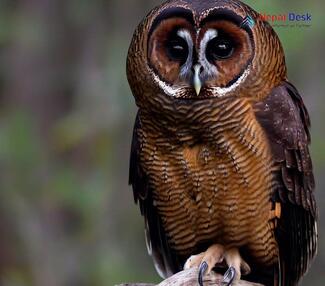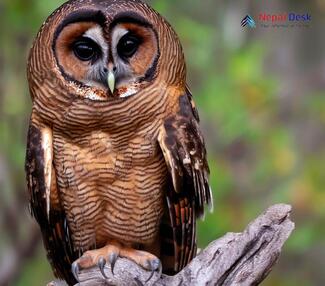The Brown Wood-Owl (Strix leptogrammica ) is a magnificent and enigmatic bird of prey, belonging to the family Strigidae, which encompasses the "true owls." Informally categorized as "Brown Owl", this species, with its rich, earthy brown plumage and hauntingly deep calls, occupies a unique niche in the forests of South and Southeast Asia. Nepal, a country renowned for its breathtaking landscapes and biodiversity, is one of the key regions where this owl thrives. The dense subtropical and temperate forests of Nepal provide an ideal habitat for the Brown Wood-Owl, allowing it to play a critical role in maintaining ecological balance. Below, we delve into an exhaustive exploration of the Brown Wood-Owl, covering its taxonomy, physical characteristics, habitat preferences, behavior, ecological significance, threats, and conservation efforts—all grounded in factual information and enriched with descriptive detail.
Taxonomy and Classification: Tracing Its Evolutionary Roots
Scientific Classification
To fully appreciate the Brown Wood-Owl, we must first understand its place within the broader tapestry of avian life. The scientific classification of this owl reveals its evolutionary lineage and relationship to other birds:
- Kingdom: Animalia
- Phylum: Chordata
- Class: Aves
- Order: Strigiformes
- Family: Strigidae
- Genus: Strix
- Species: Strix leptogrammica
The genus Strix is a distinguished group of woodland owls characterized by their rounded heads, lack of ear tufts, and cryptic plumage. These traits make them masters of stealth and camouflage, perfectly adapted to life in forested environments. The Brown Wood-Owl shares its genus with other iconic species such as the Tawny Owl (Strix aluco ), which is widespread across Europe, and the Spotted Wood-Owl (Strix seloputo ), native to parts of Southeast Asia. However, the Brown Wood-Owl stands apart due to its larger size, deeper vocalizations, and specific habitat preferences.
Subspecies Diversity
The Brown Wood-Owl exhibits remarkable diversity across its range, with several recognized subspecies that reflect adaptations to regional conditions:
- Strix leptogrammica leptogrammica: Found in Nepal, northeastern India, Myanmar, and parts of Southeast Asia. This subspecies is the most widely distributed and is commonly encountered in Nepal’s lowland Terai region and mid-elevation forests.
- Strix leptogrammica ochrogenys: Endemic to Java and Bali, this subspecies has a slightly paler plumage compared to its mainland counterparts.
- Strix leptogrammica caligata: Distributed in Sumatra and Borneo, this subspecies inhabits the dense tropical rainforests of these islands.
- Strix leptogrammica bartelsi: Restricted to the Philippines, this subspecies is smaller and has a more localized distribution.
In Nepal, the subspecies S. l. leptogrammica dominates, thriving in the country’s lush forests and contributing to the region’s rich biodiversity.
Physical Characteristics: A Masterpiece of Evolution
Size and Appearance
The Brown Wood-Owl is a medium to large-sized owl, measuring approximately 40–50 centimeters (16–20 inches) in length, with a wingspan of about 80–100 centimeters (31–39 inches). It weighs between 400–700 grams (0.88–1.54 pounds), making it a robust and formidable hunter. Its size places it among the larger members of the Strix genus, second only to species like the Barred Owl (Strix varia ) in some regions.
Its plumage is a work of art, designed by evolution to provide maximum camouflage. The upperparts are a deep, rich brown, adorned with intricate patterns of lighter streaks and bars. These markings break up the owl’s silhouette, allowing it to blend seamlessly into the dappled light of forest canopies. The underparts are lighter, with bold, dark streaks that create a striking contrast. The facial disc, a hallmark of all owls, is pale with a reddish-brown rim, drawing attention to its large, dark eyes. These eyes are not just beautiful—they are highly functional, packed with rod cells that enable exceptional night vision.
Specialized Adaptations
The Brown Wood-Owl’s feathers are marvels of natural engineering. Each feather is fringed with soft, comb-like structures that reduce turbulence and muffle sound during flight. This adaptation allows the owl to glide silently through the forest, approaching prey without detection. Its powerful talons and sharp, hooked beak are perfectly suited for capturing and dispatching prey, from rodents to reptiles.
The absence of ear tufts—a feature common in other owl genera—gives the Brown Wood-Owl a sleek, streamlined appearance. Instead, its asymmetrical ear placement enhances its ability to pinpoint sounds with incredible accuracy, even in complete darkness. This auditory precision is crucial for locating prey hidden beneath leaves or in dense vegetation.
Habitat and Distribution: A Forest Dweller’s Paradise
Global Range
The Brown Wood-Owl is a denizen of South and Southeast Asia, with a range that stretches from Nepal and northeastern India through Myanmar, Thailand, Malaysia, Indonesia, and the Philippines. It prefers dense tropical and subtropical forests, including evergreen, semi-evergreen, and moist deciduous woodlands. These habitats provide the owl with ample cover, abundant prey, and minimal human disturbance.
Presence in Nepal
Nepal, with its diverse topography and rich biodiversity, offers an ideal home for the Brown Wood-Owl. The country’s forests, ranging from the lowland Terai region to the lower slopes of the Himalayas, support healthy populations of this species. Key areas where the Brown Wood-Owl has been recorded include:
- Chitwan National Park: A UNESCO World Heritage Site and one of Nepal’s most biodiverse regions. The park’s dense sal forests and grasslands provide perfect conditions for the owl to thrive.
- Bardia National Park: Located in western Nepal, this park is another stronghold for the Brown Wood-Owl, thanks to its extensive forests and wetlands.
- Shivapuri Nagarjun National Park: Situated near Kathmandu, this park combines subtropical and temperate forests, offering a mix of habitats that suit the owl’s needs.
- Annapurna Conservation Area: While primarily known for its towering peaks, this region also supports populations of the Brown Wood-Owl in its lower-altitude forests.
These areas are characterized by dense vegetation, abundant prey, and minimal human interference, all of which are essential for the owl’s survival. The presence of large trees with natural cavities is particularly important, as these serve as nesting sites for the species.
Behavior and Ecology: A Nocturnal Hunter’s Life
Nocturnal Lifestyle
The Brown Wood-Owl is a creature of the night, emerging from its daytime roost at dusk to begin its hunt. During the day, it remains well-hidden, perched close to the trunk of a tree where its cryptic plumage blends seamlessly with the surrounding foliage. This behavior minimizes the risk of predation and conserves energy for nighttime activities.
At night, the owl becomes a master predator, relying on its acute senses to locate prey. Its large eyes gather even the faintest traces of light, while its asymmetrical ears allow it to triangulate the source of sounds with pinpoint accuracy. Whether it’s the rustle of a mouse in the undergrowth or the flutter of a bird taking flight, the Brown Wood-Owl detects and responds with lightning speed.
Vocalizations
The Brown Wood-Owl is known for its deep, resonant calls, which echo through the forest like a haunting melody. Its typical call consists of a series of hoots, often described as “who-who-who” or “hoo-hoo.” These vocalizations serve multiple purposes, including territorial defense and mate attraction. During the breeding season, pairs engage in duets, their calls intertwining in a symphony of sound that reinforces their bond.
Interestingly, the owl’s calls can carry over long distances, making it easier for researchers to monitor populations. In Nepal, local communities have long associated these calls with omens or warnings, adding a layer of cultural significance to the species.
Diet and Hunting
The diet of the Brown Wood-Owl is as varied as the ecosystems it inhabits. It preys on a wide range of animals, including small mammals (such as rodents and squirrels), birds, reptiles, amphibians, and large insects. Its hunting strategy is a testament to patience and precision. The owl employs a sit-and-wait approach, perching silently on a branch until it detects movement below. Once it locks onto its target, it swoops down with astonishing speed, using its powerful talons to capture and kill the prey.
This dietary flexibility allows the Brown Wood-Owl to adapt to changing environmental conditions. In areas where certain prey species decline, they can switch to alternative food sources, ensuring its survival.
Reproduction
Breeding season varies depending on geographic location but generally occurs during the dry months in Nepal (February to April). The Brown Wood-Owl nests in natural tree cavities or abandoned nests of other large birds, such as hornbills or eagles. These cavities provide protection from predators and harsh weather conditions.
The female lays 1–3 eggs, which she incubates for approximately 30 days. During this period, the male assumes the responsibility of providing food, and delivering prey to the nest under the cover of darkness. Once the chicks hatch, both parents participate in raising them, feeding them regurgitated food until they fledge at around 6–7 weeks old. The fledglings remain dependent on their parents for several weeks after leaving the nest, gradually learning to hunt and fend for themselves.
Ecological Role: Guardians of the Forest
The Brown Wood-Owl plays a vital role in maintaining the balance of ecosystems. As an apex predator, it helps regulate populations of rodents, insects, and other small animals, preventing outbreaks that could damage crops or spread diseases. For example, by controlling rodent populations, the owl indirectly benefits agriculture, reducing the need for chemical pesticides.
Its presence in forests also serves as an indicator of ecosystem health. Declines in owl populations may signal broader environmental issues, such as deforestation, pesticide contamination, or climate change. By monitoring the Brown Wood-Owl, scientists can gain valuable insights into the state of the environment and identify areas in need of conservation.
Threats and Conservation Challenges
Habitat Loss
One of the primary threats to the Brown Wood-Owl in Nepal is habitat destruction. Deforestation driven by agriculture, logging, and infrastructure development has led to the fragmentation of forests, reducing available nesting sites and prey abundance. Urbanization and road construction further exacerbate the problem, isolating populations and limiting genetic exchange.
Human-Wildlife Conflict
In some areas, owls are still viewed with superstition and fear, leading to persecution. Although direct hunting is less common today, indirect threats such as poisoning (intended for other pests) pose significant risks. Pesticides and rodenticides accumulate in the food chain, causing secondary poisoning in owls that consume contaminated prey.
Climate Change
Changes in rainfall patterns and rising temperatures could alter the composition of forests in Nepal, potentially affecting the availability of suitable habitats for the Brown Wood-Owl. Droughts and extreme weather events may also impact prey populations, further stressing the species.
Conservation Status and Efforts
IUCN Red List Status
The Brown Wood-Owl is currently listed as Near Threatened on the IUCN Red List due to ongoing population declines caused by habitat loss and degradation. While it remains relatively widespread, localized extinctions have been reported in heavily deforested regions.
Protected Areas
In Nepal, several national parks and conservation areas provide refuge for the Brown Wood-Owl. These include Chitwan National Park, Bardia National Park, and Annapurna Conservation Area. Strict enforcement of anti-poaching laws and sustainable forestry practices are critical for safeguarding these habitats.
Community Involvement
Local communities play a crucial role in conservation efforts. Awareness campaigns educate people about the importance of owls in ecosystems and dispel myths that contribute to their persecution. Eco-tourism initiatives also incentivize the protection of wildlife by generating income for local economies.
Conclusion: Guardians of Nepal’s Forests
The Brown Wood-Owl (Strix leptogrammica ) is a remarkable bird that embodies the beauty and complexity of Nepal’s natural heritage. With its haunting calls, silent flight, and vital ecological role, it serves as both a symbol of wilderness and a reminder of our responsibility to protect it. By addressing the threats it faces and supporting conservation efforts, we can ensure that future generations will continue to marvel at this magnificent owl in the forests of Nepal.




